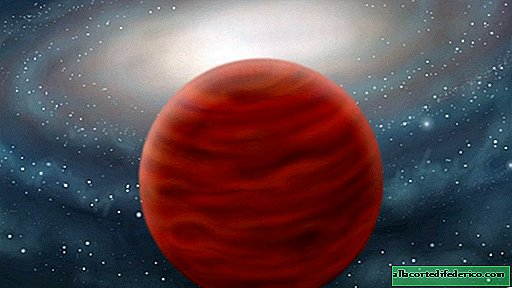Astronomers have found a star smaller than Jupiter
Stars are always associated with something very big. These are indeed one of the largest objects in the Universe: even our Sun refers only to “yellow dwarfs”. But recently astronomers have discovered a record small star, which is smaller than Jupiter - the largest planet in the solar system, but still the planet. Scientists believe that if it were even smaller, simply could not exist.
Without gravity, nowhere
First of all, what is a star? This is a huge gas ball that emits bright light and heat. Stars are kept in equilibrium by their own gravity and strong internal pressure. Inside this ball, a fusion reaction occurs (due to the combustion of hydrogen). Gravity of an object directly depends on its size: the larger the star, the higher the gravity.

Accordingly, if the object is too small, it simply cannot exist as a star. For such objects there is a name - "brown dwarf". Thermonuclear reactions of light nuclear elements (lithium, beryllium, boron, etc.) can also occur in them, but they are not enough for hydrogen, and after the exhaustion of reserves of light elements, the object quickly cools. All brown dwarfs have approximately the same size (with Jupiter), and a much higher density compared to this planet.
Cold star
The recently discovered star EBLM J0555-57Ab is located about 600 light years from the Sun. It was discovered by Cambridge astronomers. According to their estimates, this star is smaller and, apparently, colder than most exoplanets (that is, planets outside the solar system). It is even smaller than one of the smallest known stars to date TRAPPIST-1.
Since it is very small, it is almost impossible to find it due to its own radiance. Therefore, the same method that was used in the search for new exoplanets helped here: astronomers look at the vibrations of large stars and wonder what gravity of which objects could cause them.

In the photo: comparative sizes of Jupiter, Saturn, EBLM J0555-57Ab and TRAPPIST-1 / Source: Boetticher et al
The EBLM star J0555-57Ab is part of a binary system, so it constantly moves around its brighter “neighbor”. These fluctuations allowed us to assume that the radius of the star is approximately 0.84 of the radius of Jupiter, and the mass is 85 masses of the largest planet in the solar system.
Due to such a high density, the attraction on the surface of a star is 300 times greater than on Earth. Scientists believe that if EBLM J0555-57Ab were even slightly smaller, it would turn into a brown dwarf.

















